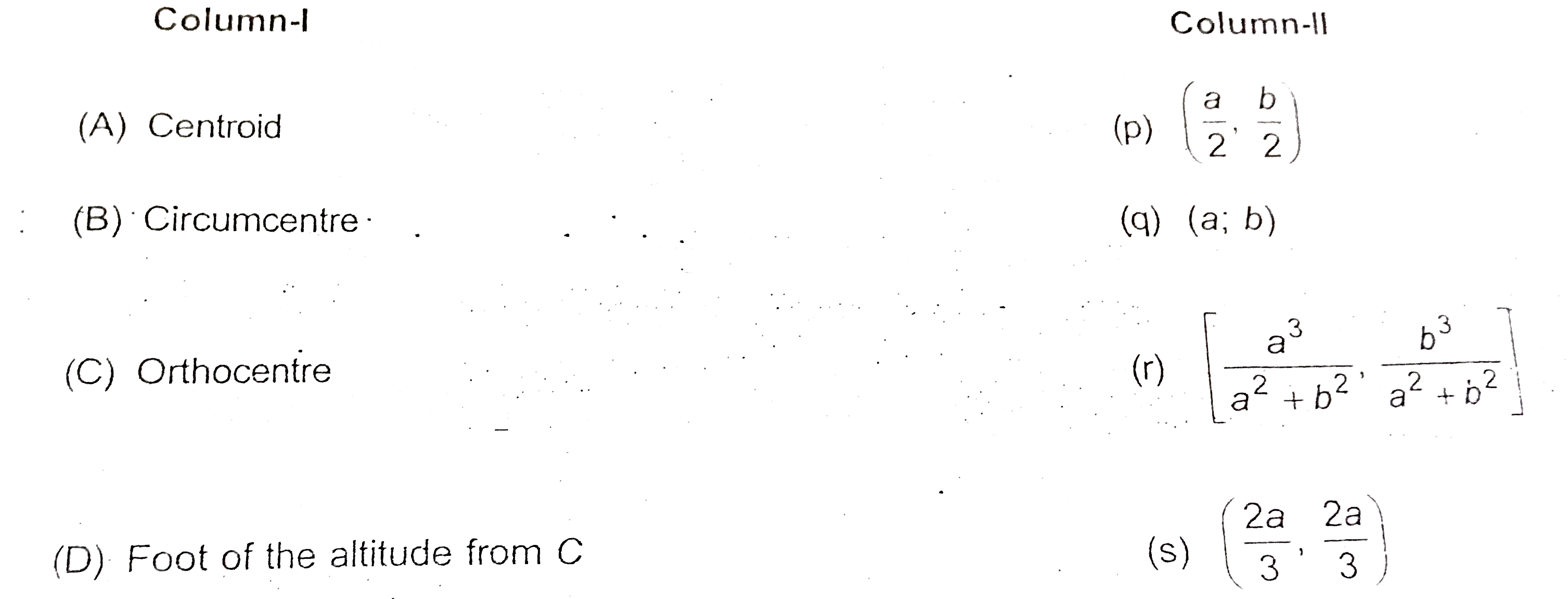a and b are real numbers between 0 and 1 A(a,1),B(1,b)andC(0,0) are the vertices of a triangle.
If ∠C=90∘ then
a+b=0
a−b=0
a+b=1
a−b=1
The correct Answer is:A
To solve the problem, we need to find the relationship between the real numbers a and b given that the triangle formed by the points A(a,1), B(1,b), and C(0,0) has a right angle at point C.
1. Identify the Points:
- The points of the triangle are A(a,1), B(1,b), and C(0,0).
2. Find the Slopes:
- The slope of line segment AC is calculated as:
slope of AC=y2−y1x2−x1=1−0a−0=1a
- The slope of line segment BC is calculated as:
slope of BC=b−01−0=b
3. Use the Right Angle Condition:
- Since ∠C is 90∘, the product of the slopes of lines AC and BC must be equal to −1:
slope of AC⋅slope of BC=−1
Substituting the slopes we found:
1a⋅b=−1
4. Set Up the Equation:
- Rearranging the equation gives:
b=−a
5. Consider the Constraints:
- Since a and b are both real numbers between 0 and 1, the equation b=−a implies that both a and b cannot simultaneously satisfy this equation within the given range. Therefore, we conclude that there is no valid solution for a and b under the constraints provided.
Conclusion:
The relationship derived from the right angle condition leads to an inconsistency with the constraints that a and b must be between 0 and 1. Thus, no valid values for a and b exist under the given conditions.
- The points of the triangle are A(a,1), B(1,b), and C(0,0).
- The slope of line segment AC is calculated as:
slope of AC=y2−y1x2−x1=1−0a−0=1a
- The slope of line segment BC is calculated as:
slope of BC=b−01−0=b
- Since ∠C is 90∘, the product of the slopes of lines AC and BC must be equal to −1:
slope of AC⋅slope of BC=−1
Substituting the slopes we found:
1a⋅b=−1
- Rearranging the equation gives:
b=−a
- Since a and b are both real numbers between 0 and 1, the equation b=−a implies that both a and b cannot simultaneously satisfy this equation within the given range. Therefore, we conclude that there is no valid solution for a and b under the constraints provided.
The relationship derived from the right angle condition leads to an inconsistency with the constraints that a and b must be between 0 and 1. Thus, no valid values for a and b exist under the given conditions.
Topper's Solved these Questions
- STRAIGHT LINESBOOK - AAKASH INSTITUTE ENGLISHCHAPTER - STRAIGHT LINESEXERCISE - SECTION-E (ASSERTION-REASON TYPE QUESTIONS)
6 Videos
- STRAIGHT LINESBOOK - AAKASH INSTITUTE ENGLISHCHAPTER - STRAIGHT LINESEXERCISE - SECTION-F (MATRIX-MATHC TYPE QUESTION)
3 Videos
- STRAIGHT LINESBOOK - AAKASH INSTITUTE ENGLISHCHAPTER - STRAIGHT LINESEXERCISE - ASSIGNMENT (SECTION C) (OBJECTIVE TYPE QUESTIONS) (MORE THAN ONE ANSWER)
14 Videos
- STATISTICSBOOK - AAKASH INSTITUTE ENGLISHCHAPTER - STATISTICSEXERCISE - Section-C Assertion-Reason
15 Videos
- THREE DIMENSIONAL GEOMETRY BOOK - AAKASH INSTITUTE ENGLISHCHAPTER - THREE DIMENSIONAL GEOMETRY EXERCISE - ASSIGNMENT SECTION - J
10 Videos
Similar Questions
a and b are real numbers between 0 and 1 A(a,1),B(1,b)andC(0,0) are the vertices of a triangle.
If ΔABC is equilateral its area is
View Solutiona and b are real numbers between 0 and 1 A(a,1),B(1,b)andC(0,0) are the vertices of a triangle.
If ΔABCis isosceles with AC=BCand5(AB)2=2(AC)2 then
View SolutionThe points A(3,1) , B (12,-2) and C(0,2) cannot be vertices of a triangle.
View SolutionThe vertices of a triangle are A(a,0)B(0,b)andC(a,b)

View SolutionProve that the points A(1,−3),B(−3,0)andC(4,1)are the vertices of a right angled Isosceles triangle
View SolutionIf a and b are two real number lying between 0 and 1 such that z1=a+i,z2=1+biandz3=0 form an equilateral triangle , then (A) a=2+√3 (B) b=4−√3 (C) a=b=2−√3 (D) a=2,b=√3
View SolutionShow that the points A(2,-1,3),B(1,-3,1) and C(0,1,2) are the vertices of an isosceles right angled triangle.
View SolutionThe number of primes between 90 and 100 is
(a) 0
(b) 1
(c) 2
(d) 3
View SolutionThe points A(3,0) , B (a, -2) and C(4, -1) are the vertices of triangle ABC right angled at vertex A. Find the value of a.
View Solutiona and b are real numbers between 0 and 1 such that the points Z1=a+i, Z2=1+bi, Z3=0 form an equilateral triangle, then a and b are equal to
View Solution
